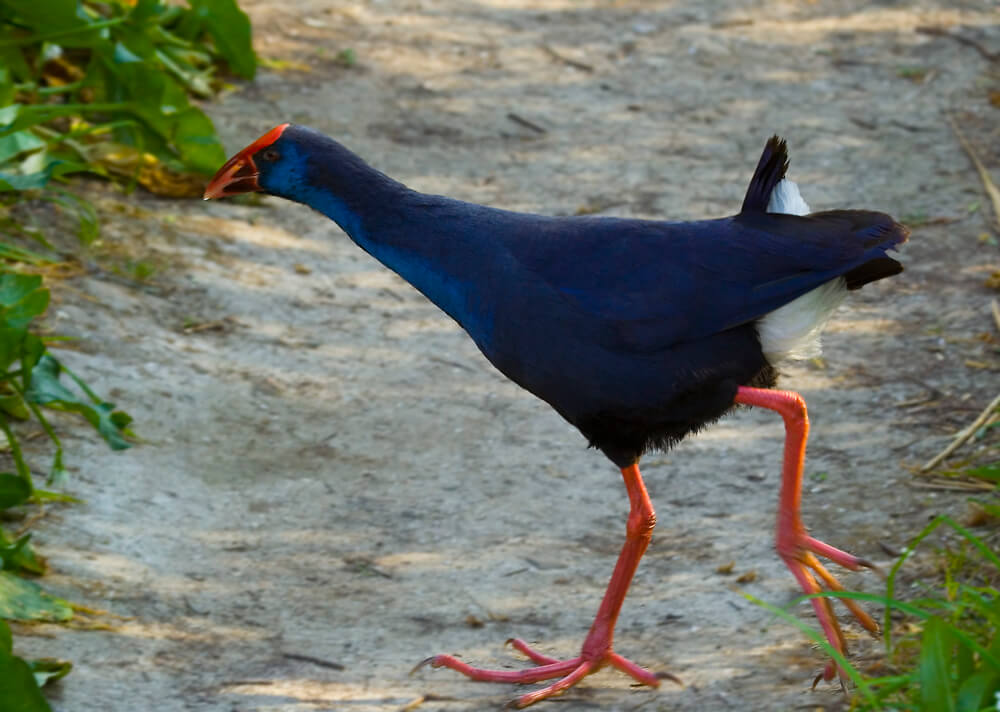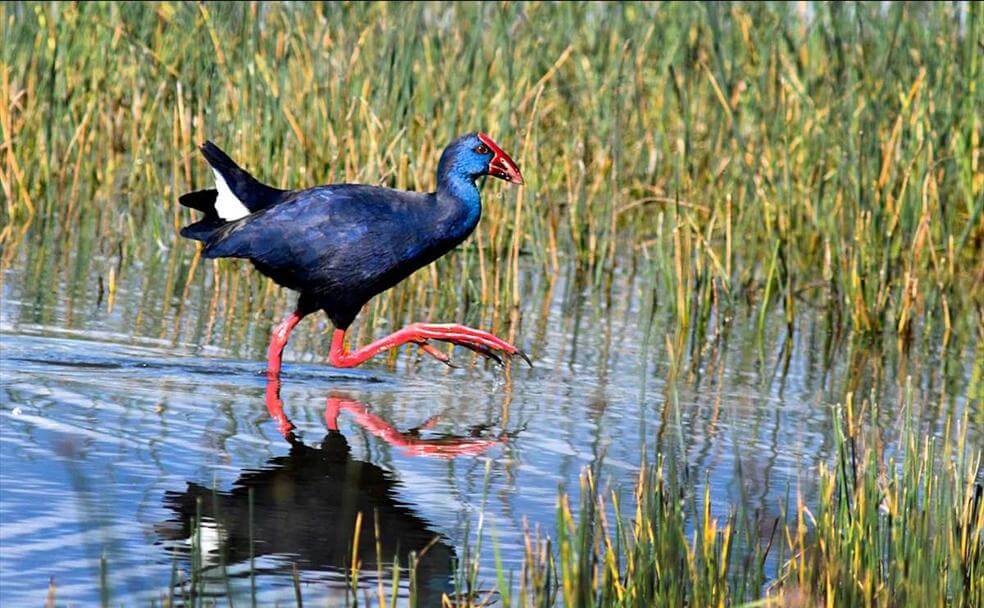The Purple Swamphen: Habitat, Characteristics and Diet

The purple swamphen is a waterfowl worth knowing about, and we’ll help you differentiate it from other members of its taxonomic group. Its long legs, together with its frontal shield and blue plumage are the characteristics you need to recognize it.
If you’re interested in these beautiful species, we’ve got all the information on this particular bird. Don’t miss it, because getting to know our environment and the living beings that inhabit it is one more step to help us appreciate and conserve the world we live in.
Taxonomy and characteristics
The purple swamphen (Porphyrio porphyrio) belongs to the order of Gruiformes, which cranes and skuas also belong to. Its family, Rallidae, includes numerous species, among them the coots, which it’s often confused with.
The purple swamphen, however, is almost twice as large as the coots. It measures between 45 and 50 centimeters in height (18 to 20 inches), with a wingspan of 90-100 centimeters (36 to 40 inches). Its plumage is also dark, but reflects bluish or purplish tones. In the tail area, there’s a characteristic snowy white part. In contrast to all this are its beak, frontal shield, and legs, which are bright red.
Habitat
Its range extends from southern Europe and Africa to the easternmost part of Asia (Australasia). Populations are widely scattered, but nesting sites have been identified in the extreme south of the Iberian Peninsula, southern France, Sardinia, southern Turkey, Morocco, Algeria, Tunisia, the Caspian Sea, and Egypt.
The purple swamphen inhabits freshwater and brackish wetlands with abundant vegetation, preferably those that don’t dry out seasonally, such as marshes and swamps. Although it moves well in water, it tends to prefer shallow areas, where it can take off and land in case of danger (and where there’s vegetation to hide in).
Purple swamphen feeding
This bird is omnivorous, and its main diet consists of the vegetation around it: green shoots, aquatic plants (rushes, rice, sedge, clover, etc.) and seeds. This is supplemented with some animal protein in the form of insects and occasionally some mollusks such as snails. On very rare occasions they have been found preying on fish, small birds, or even waterfowl such as ducks.
To help them grind their food they ingest sand and other types of sediment.
Behavior
The purple swamphen is a diurnal and gregarious bird. They’re quite territorial in nature, as all flock members defend their chosen territory, especially during the breeding season. To do so, they resort to warnings in the form of vocalizations, such as cries and calls.
A curious aspect is the way they warn their predators that they have been discovered. They use small movements that make the target of their tails suddenly visible. In this way, they avoid confrontation when possible.
On the other hand, there is a clear hierarchy within the groups. The ordering criteria are size and age, as well as sex. There’s usually a dominant pair that establishes the order of reproduction, in addition to being the oldest and the largest.
Reproduction of the purple swamphen
The reproduction period varies, according to the area of distribution, since this is very wide, although it always coincides with the rainy season. This doesn’t apply in areas where populations are particularly large, as they’re monogamous and territorial birds.
On the other hand, there’s also communal breeding, in which breeding females share a nest and are fertilized by several males. In these cases, the whole group participates in rearing the chicks and incubating the eggs: mothers, fathers and the rest of the individuals in the group, including juveniles.
Males show an elaborate courtship ritual, in which they hold a rod with their beaks, vocalize and bow.
Each female lays 3 to 6 eggs, and one more if she’s dominant. Hatching occurs after 23-29 days. Generally, it’s the female who incubates the longest, as the males concentrate on defending the nest, but it’s very common for them to change places and for the juveniles to learn breeding from their elders.
Conservation status

Porphyrio porphyrio is currently in a status of least concern. It’s unknown how many breeding individuals exist, as populations are widespread and distributed over large tracts of land, but they aren’t considered to be in imminent danger of extinction.
However, we must also realize that this species is suffering from habitat loss due to wetland drainage and the introduction of exotic species such as the coypu (Myocastor coypus). Water contamination with pesticides and toxins, as well as avian influenza and avian botulism are other threats they face.
So, we should strive to get to know all the planet’s inhabitants. We need all these species to continue to prosper so that we can continue to enjoy them.
All cited sources were thoroughly reviewed by our team to ensure their quality, reliability, currency, and validity. The bibliography of this article was considered reliable and of academic or scientific accuracy.
- Porphyrio porphyrio (purple swamphen). (s. f.). Animal Diversity Web. https://animaldiversity.org/accounts/Porphyrio_porphyrio/
- BirdLife Internacional. 2019. Porphyrio porphyrio (versión modificada de la evaluación de 2016). La Lista Roja de Especies Amenazadas de la UICN 2019: e.T22692792A155531172. https://dx.doi.org/10.2305/IUCN.UK.2016-3.RLTS.T22692792A155531172.en. Consultado el 14 de noviembre de 2022.
- Hiraldo, F., Álvarez, F., & Valverde, J. A. (1974). Biometría y dimorfismo sexual en el calamón (Porphyrio porphyrio). Doñana Acta Vertebrata, 1, 103-108.
